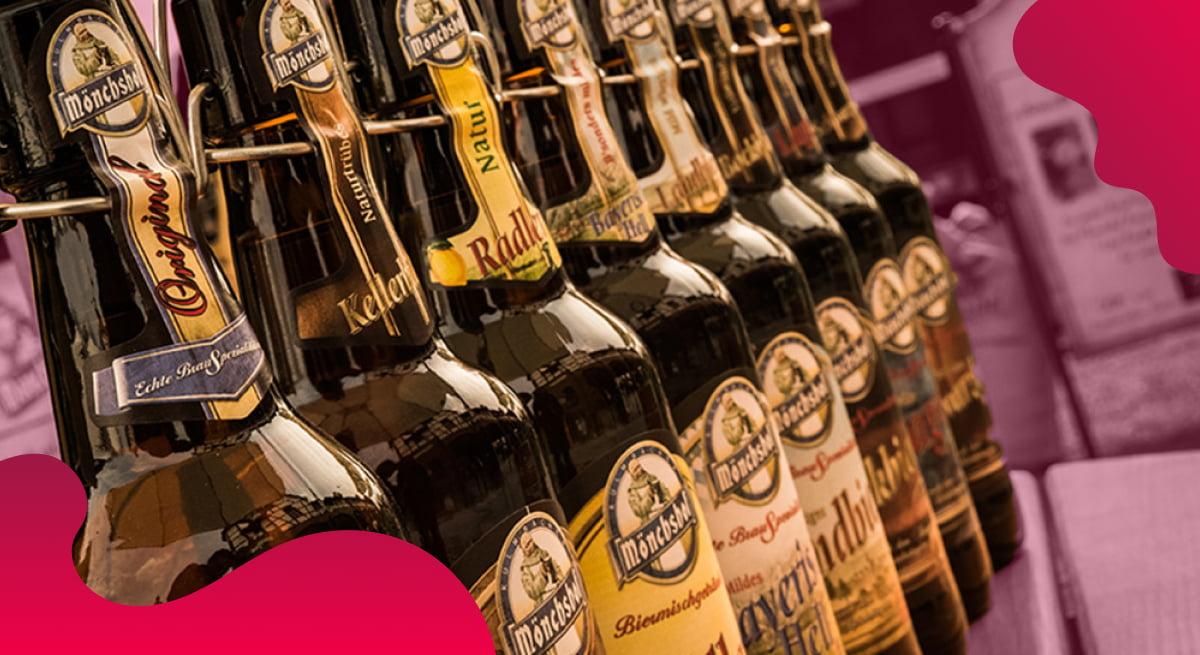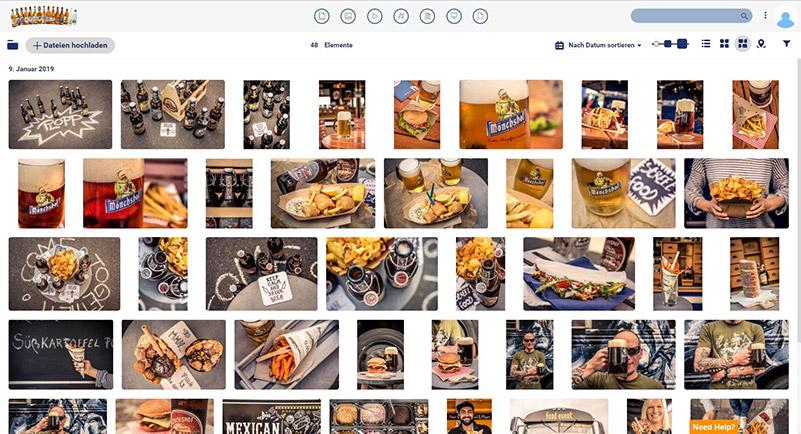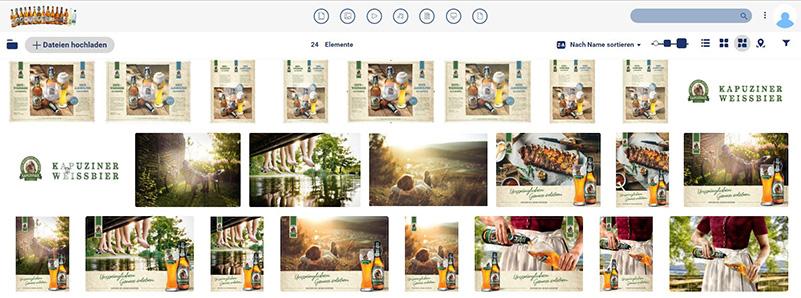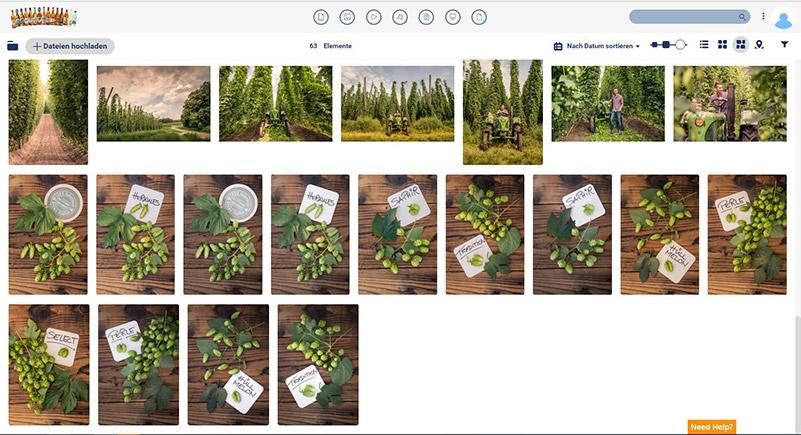Kulmbacher Brewery centralizes brand assets with Canto

As assistant to the Head of Marketing, Kerstin Krämer is in charge of coordinating ongoing projects at the Kulmbacher Brewery. From outside inquiries to media orders, anything having to do with the brewery‘s day-to-day business ends up on her desk. To complete these demanding assignments, first and foremost, she needs to have a good overview and clear agreements.
However, in the past, a major hurdle was that the print templates were not centrally organized, but rather scattered across different storage locations: network drives, cloud storage and hard drives.
The challenge
In the beginning of 2018, the Kulmbacher Brewery decided to look for a technically advanced solution. The goal here was not only to centralize the brewery‘s media files, but also to improve the completion of typical assignments in everyday business. “We didn‘t want just a cosmetic change,“ notes Kerstin Krämer, since for Kulmbacher, changes to a product image are also of legal relevance. “Here, a minor detail on a label might change, for example. If a colleague then still uses an old version without noticing it right away, it‘s not only annoying but it can come back to haunt us in regards of food law.“ Ultimately, the company went with Canto based on its performance, data security and user-friendliness.
The solution
As with any move, before the migration Kerstin Krämer and her project team had to think about what files would generally have to be present in Canto in the future, and then about how to organize them. Should one-time elements such as for example Facebook posts be archived? Or only the image used in this post? During the first phase, the Krämer‘s team came up with a concept for the structure of files and metadata which also took into account how their colleagues searched for media files.

The biggest logistic effort then consisted of collecting and importing the files. After all the files were sorted in Canto, the system was ready to launch. First and foremost, this affected the marketing team, comprising around 15 users, most of whom have read-only access to the content. However, thanks to Canto‘s support, the system was continuously improved and further adapted to the users‘ situation, Kerstin Krämer recalls. “A few times, I also asked questions by submitting tickets to Canto support and they were quickly answered. That was a big help.“
Besides the internal users, the various agencies the Kulmbacher Brewery works with are also connected to Canto. That eliminates the hassle of having to transfer large files on USD flash drives.
Results and benefits
Image requests from sales no longer end up in Kerstin Krämer‘s email inbox since her colleagues can help themselves to a collection of released images, which saves a lot of time and effort for all involved. Initially, Kerstin Krämer had thought about conducting a workshop to explain how to use the new software. But that quickly turned out to be unnecessary. Her colleagues had no problems getting used to the easy and intuitive tools.

Kulmbacher now organizes more than 5,000 important media files, from ads and presentations all the way to movie and TV commercials. After photo sessions, in some cases, product photographers upload hundreds of photos straight to Canto. There, the photos can be reviewed and catalogued and forwarded for image retouching. They are then available be used via download links and agency access. So, Canto has played a decisive part in forming better and more efficient work processes. “Ultimately, we want everything to go through Canto and gradually say goodbye to our former file chaos,“ says Kerstin Krämer, summarizing the project. Her favorite feature is the add-on for the Chrome browser which helps users to quickly access content in Canto in any situation. “I really use it very often. A colleague saw me doing that and said: Wow, that‘s cool!“
And here’s what our customers said in the interview
No two companies are alike. That’s why we introduce our customers and talk with them about how they use Canto. Together with its subsidiaries, the Kulmbacher Brewery Corporation (Kulmbacher Brauerei AG) produces a wide variety of specialty beers and non-alcoholic beverages. We spoke with Kerstin Krämer about her job as assistant to the marketing director.
What is your job at Kulmbacher?
As assistant to the marketing director, I coordinate ongoing projects in-house and I’m in charge of outside inquiries that come in through our info mail accounts. I also handle media orders for our brands and I’m responsible for our Canto media library.
Our marketing team is made up of a marketing director, product managers, a press officer, an event team and me.

When did you first come into contact with the topic of DAM? And at what point did you decide to implement Canto?
I was already familiar with digital asset management as a technology in very simplified form from my previous employer. Ultimately, the initiative to introduce a DAM system at Kulmbacher came from our marketing director. Over time, a very large number of media files had built up at the company: pictures, logos, commercials for movie theaters, TV and radio, but also print data, e.g. from advertisements or posters. It was all spread out over various storage locations. If you wanted to find something specific, you had to click through a lot of folders. That’s why, at that point, we decided to look for a DAM system.
What was the main factor for you there – saving time or being better organized?
Initially, saving time was secondary for us. However, since introducing Canto, we’ve noticed that many work processes are now also faster and more efficient. But the main reason was quite simply to centralize our media content. Also, to simplify typical attributions in day-to-day business, for example, to clearly save information about which product image is authorized for use and in the current version.
The goal was for every user to have access to the media data – but only to the most current. For instance, a minor detail on a label might be changed. If a colleague then nonetheless uses an older version without noticing this right away, it’s not only annoying but it may also result in repercussions in terms of food legislation. So, this isn’t just a cosmetic issue.

How did you manage the migration of your new DAM project with Canto?
We used a small project team. Besides the marketing department, IT was also on board and checked in advance what systems would even be eligible in terms of performance, how things would look in terms of data security, etc. In this context, we agreed on three providers. We carefully examined these three eligible systems with web sessions and test accounts among other things. Ultimately, we went with Canto.
We then got together to reflect on: What do we want to include in our new system? Do we really want to toss in all the little things we’ve got stored on our drives, i.e. even one-time materials like a Facebook post? Or perhaps only the image used for this post and that we could re-use. How and according to what criteria would our colleagues use the search function?
The hard and, most of all, more time-consuming part was then to collect all the data that seemed important for us for the first upload. We brought in the rest of our colleagues from marketing to do that. Thereafter, we successively added our stock of media files.
So, when was this first project phase completed?
We performed the migration of our media files in parallel with the day-to-day business. By now, we’ve added the bulk of the data. Sometimes, we still add data that we hadn’t considered before and we naturally add completely new data on a regular basis e.g. from new product photos.
The idea of us getting a digital asset management system came up at the beginning of 2018 and since summer 2018 we’ve actually been working with it. In total, it took around 4-5 months from idea to implementation.
What you also need to consider in this regard: It doesn’t always immediately run smoothly and without any hiccups. Especially at the beginning, you keep finding procedures and tasks you can improve by yourself, whether it’s correctly assigning keywords or linking data within the right folders of the tree structure. A few times, I also asked questions by submitting tickets to Canto support and they were quickly answered. That was a big help.
Which of your departments and colleagues are connected to Canto?
First and foremost, Canto is intended for use by our marketing. There are around 15 users. Most of them have read privileges and can download any files. Five administrators care for the system, including one colleague from IT.
But we also work together with various agencies. They also each have a user account to access our image material, so we no longer have to send out flash drives, as was the case before we introduced Canto.
Other departments get connected as needed. A little while ago, a colleague from sales called up asking for images – nothing in particular, just general image files. I gave him access to the system, so he can select the appropriate images himself. Not only do our colleagues find this useful, but it’s also more efficient for me to just create an account instead of looking for image material that I perhaps like individually but which isn’t suitable for the sales department or their project.
How did you convey the added value of your system to your colleagues?
Initially, I created a guide, so my colleagues could look up how to find their way around Canto. However, since for most users, only very few tasks are relevant, getting started was really easy.
Initially, we had considered organizing a workshop to introduce our colleagues to working with Canto. But, since Canto is so user-friendly and easy to use, it wasn’t necessary.

What types of media files do you manage in Canto?
The bulk of our media files are pictures, whether it’s product photos and image files or photos from events. All types of logos, commercials for movie theaters or radio, print data, e.g. from posters and advertisements, presentations, too. I would say: it’s a mixed bag. I checked in the dashboard: Currently, we have almost 5,000 files, which is quite a large amount. I would never have expected that many!
They accumulate rather quickly.
Yes. Especially when you’ve also got different versions, e.g. for logos or product images. As cropped images, with and without backgrounds, logos in color, grayscale or black and white. There’s a lot of stuff that accumulates!
So, what does a typical workflow look like for you? Where do the files come from?
Ideally, it’s like this: We receive photos from a photographer, e.g. from a new product. We generally get a few hundred, although we end up selecting and using only 5 or 10 photos. These are then uploaded to Canto by the photographer via the upload link. The colleagues in charge review the photos and select the ones that should actually be used. After making any possibly required touch-ups, the images are then re-uploaded via the upload link and then tagged by us directly in the main library.
In the next step, the agency handling graphics, e.g. for creating an advertisement or a Facebook post, will receive access to the images. Or we use the images in-house for presentations, etc. From here, further use is flexibly determined. Ultimately, we want everything to go through Canto and gradually say goodbye to our former file chaos.
So, who’s in charge of system maintenance at Kulmbacher?
As mentioned, there are five administrators in total. I’m responsible for maintenance, but when I’m not available, other admins also handle it. Another colleague also uploads data on certain topics in some cases. However, when it’s a matter of removing a product or modifying product photos, I’m the one who does that. This ensures that the tagging is uniform. This applies to little things such as typos, capital and lower-case letters since the quality of the metadata is also decisive.

What is your favorite feature?
I really use Chrome extension for Canto very often, which you can install in the browser bar. A colleague saw me doing it and said: Wow, that’s cool!
The upload and download links are a hit as well. I also find it really useful to re-crop pictures before downloading or to convert them to a new image format.
How much time do you spend in Canto every day?
It really varies. On average, I’d say 15-30 minutes a day. Sometimes more, depending on what I happen to be working on. We recently had a shareholders’ meeting and I used Canto every day for a long time to prepare the presentations for it.
Canto is always open in my browser.